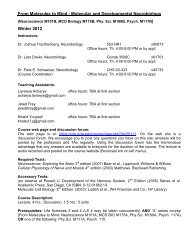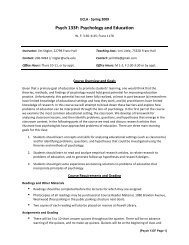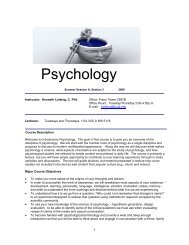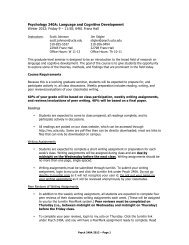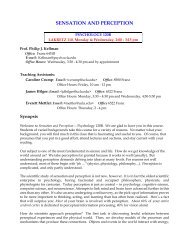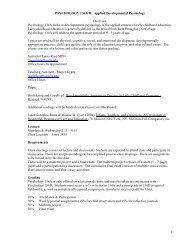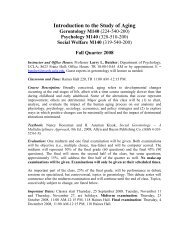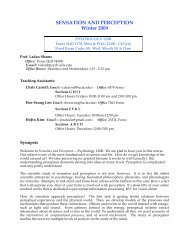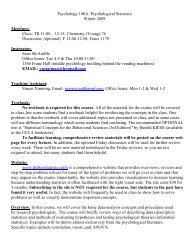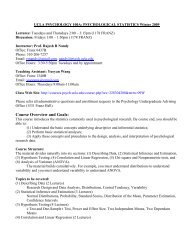SYLLABUS - Courses in Psychology - UCLA
SYLLABUS - Courses in Psychology - UCLA
SYLLABUS - Courses in Psychology - UCLA
Create successful ePaper yourself
Turn your PDF publications into a flip-book with our unique Google optimized e-Paper software.
Required Text<br />
Kazd<strong>in</strong>, A. E. (2003). Research Design <strong>in</strong> Cl<strong>in</strong>ical <strong>Psychology</strong>, Fourth edition. Boston, MA; Alyn & Bacon.<br />
We will place copies of this book on reserve <strong>in</strong> the biomed library.<br />
Grad<strong>in</strong>g<br />
1. Class attendance and PARTICIPATION: 15% of grade<br />
2. Completion of assignments for <strong>in</strong>-class experiment and cod<strong>in</strong>g exercises: 15% of grade<br />
3. Written evaluation of coded paper: 20% of grade<br />
4. Written report of your s<strong>in</strong>gle case study: 30% of grade<br />
5. Presentation of your s<strong>in</strong>gle case study: 20% of grade<br />
Requirements for Evaluation of Coded Paper<br />
Your evaluation must be 2-4 pages, double-spaced, 12-po<strong>in</strong>t font, with 1” marg<strong>in</strong>s. It should be<br />
based on the cod<strong>in</strong>g performed <strong>in</strong> class and should focus on what you see as the major strengths<br />
and weaknesses of the study from a research design perspective.<br />
Requirements for Paper<br />
Your paper must be 10-12 pages, double-spaced, 12-po<strong>in</strong>t font, with 1” marg<strong>in</strong>s, presented <strong>in</strong> the<br />
standard format of the American Psychological Association, with the standard sections of a Title Page,<br />
Abstract, Introduction, Methods, Results, Discussion, References and Tables/Figures. An example of<br />
page allocation is one half page for Abstract, 2 pages for Introduction, 1 page for Methods, 2 pages<br />
for Results, 2 pages for Discussion, 1 page for References, 1 page for Tables/Figures. The<br />
Introduction must present a background and rationale that <strong>in</strong>cludes at least 3 research articles<br />
relevant to your study; the Methods must <strong>in</strong>clude a detailed statement of s<strong>in</strong>gle case design,<br />
procedures (<strong>in</strong>tervention strategies) and measures (dependent variables); the Results must <strong>in</strong>clude<br />
graphical and/or table display of the data; and the Discussion must <strong>in</strong>clude a summary of the results,<br />
<strong>in</strong>terpretation of the results, consideration of the f<strong>in</strong>d<strong>in</strong>gs <strong>in</strong> relation to exist<strong>in</strong>g research, the<br />
limitations to the f<strong>in</strong>d<strong>in</strong>gs (i.e., <strong>in</strong>ternal validity, external validity, dependent variables, confounds),<br />
and directions for future research.<br />
Requirements for Presentation<br />
Your presentation must use visual aids (powerpo<strong>in</strong>t, handouts) to show the practices used and the<br />
progress observed <strong>in</strong> your s<strong>in</strong>gle case study. It should outl<strong>in</strong>e: (1) the problem, (2) studies relevant<br />
to its treatment, (3) <strong>in</strong>terventions chosen, (4) evaluation design and measures, (5) results, and (6)<br />
<strong>in</strong>terpretation. The presentation should be about 10-12 m<strong>in</strong>utes, and it can be as few as 6 slides<br />
cover<strong>in</strong>g the topics above.



